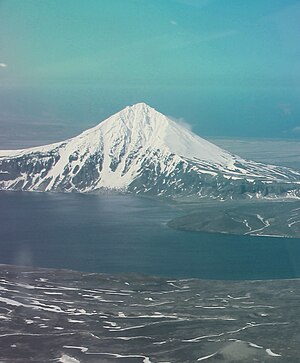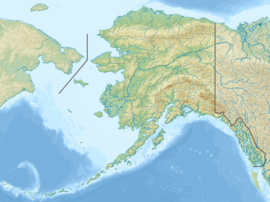Earth:Eickelberg Peak
| Eickelberg Peak | |
|---|---|
 Aerial view of east aspect | |
| Highest point | |
| Elevation | 3,648 ft (1,112 m) [1][2] |
| Prominence | 3,298 ft (1,005 m) [1] |
| Parent peak | Westdahl Volcano (5,426 ft)[1] |
| Isolation | 9.72 mi (15.64 km) [1] |
| Coordinates | [ ⚑ ] : 54°40′35″N 164°28′52″W / 54.6764365°N 164.4811514°W [3] |
| Geography | |
| Country | United States |
| State | Alaska |
| Borough | Aleutians East |
| Protected area | Aleutian Islands Wilderness |
| Parent range | Aleutian Range[2] |
| Topo map | USGS Unimak C-2 |
| Geology | |
| Age of rock | Late Pleistocene[4] |
| Mountain type | Stratovolcano[4] |
| Type of rock | Andesitic |
| Volcanic arc/belt | Aleutian Arc |
Eickelberg Peak is a 3,648-foot-elevation (1,112-meter) summit in Alaska, United States.
Description
Eickelberg Peak is an Aleutian Range stratovolcano located along the west rim of Fisher Caldera on Unimak Island of the Aleutian Islands.[5] Precipitation runoff from the mountain's east slope drains into the caldera and from the other slopes into tributaries of the Pogromni River. Topographic relief is significant as the summit rises approximately 3,050 feet (930 meters) above a caldera lake in less than one mile (1.6 km). The nearest community is False Pass, 44 miles (71 km) to the east-northeast.[4] The mountain was named after Lieutenant Commander Ernest Werner Eickelberg (1890–1941), who was involved in triangulation and topography with the United States Coast and Geodetic Survey in Alaska.[6] The mountain's toponym was published on a 1951 map by the United States Geological Survey and has been officially adopted by the United States Board on Geographic Names.[3][7]
Climate
According to the Köppen climate classification system, Eickelberg Peak is located in a subpolar oceanic climate zone with cold, snowy winters, and cool summers.[8] Weather systems coming off the North Pacific are forced upwards by the mountains (orographic lift), causing heavy precipitation in the form of rainfall and snowfall. Winter temperatures can drop to 0 °F with wind chill factors below −10 °F.
See also
References
- ↑ 1.0 1.1 1.2 1.3 "Eickelberg Peak - 3,648' AK". https://listsofjohn.com/peak/185068.
- ↑ 2.0 2.1 "Eickelberg Peak, Alaska". http://www.peakbagger.com/peak.aspx?pid=362.
- ↑ 3.0 3.1 "Eickelberg Peak". United States Geological Survey. https://geonames.usgs.gov/apex/f?p=gnispq:3:::NO::P3_FID:1418544.
- ↑ 4.0 4.1 4.2 "Eickelberg Peak description and information". Avo.alaska.edu. https://www.avo.alaska.edu/volcanoes/volcinfo.php?volcname=Eickelberg%20Peak%20%28Cone%208%29.
- ↑ Lee Siebert, Volcanoes of the World: Third Edition, 2011, University of California Press, ISBN:9780520947931, p. 398.
- ↑ "Eickelberg Peak, Peakvisor.com". https://peakvisor.com/peak/eickelberg-peak.html.
- ↑ Donald J. Orth, Dictionary of Alaska Place Names, U.S. Government Printing Office, 1967, page 304.
- ↑ Peel, M. C.; Finlayson, B. L.; McMahon, T. A. (2007). "Updated world map of the Köppen−Geiger climate classification". Hydrol. Earth Syst. Sci. 11. ISSN 1027-5606.
External links
- Weather forecast: Eickelberg Peak
- Ernest W. Eickelberg biography and photo: Arlingtoncemetery.net
Template:Geographic Location 2
 |



